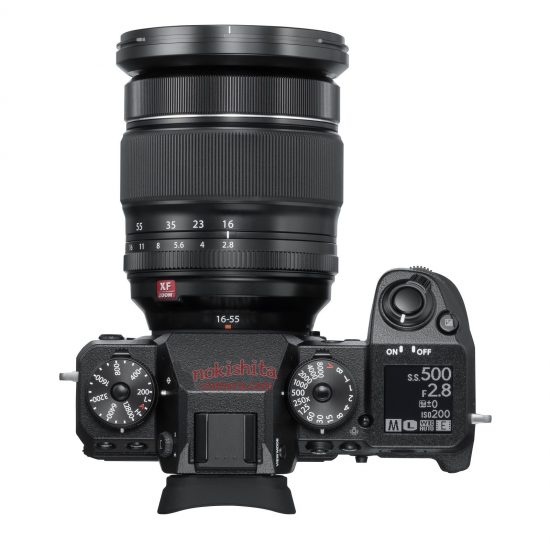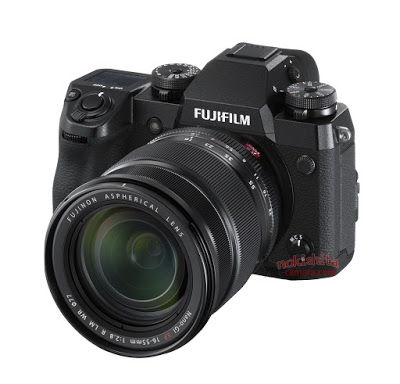
Leaked pictures of the new Fuji X-H1 on Nokishita.com disclose that the X range topper will feature a LCD status screen. After the lead Leica SL, CL and Panasonic Lumix G9, Fuji’s adoption of this DSLR-style panel tells use that it will soon be a must-have feature on mirrorless cameras.
The X-H1, a more chunky pro camera brings five-axis in-body stabilisation, said to offer a 5.5-stop advantage, an electronic front-curtain shutter and improved autofocus over the X-T2. It has the same 24.3MP X-Trans III sensor as the X-T2 but a larger, much improved 3.69m dot EVF. Body weight is 673g compared with 507g of the current range topper, the X-T2.
You can find a full comparison specification between the X-H1 and the X-T2 here at PhotoRumors.
________________


I’m late to this post but would add:
Fuji have long produced military grade stabilised binoculars so their stabilisation technology is second to none. It is therefore great to see in body stabilisation introduced to their camera range. It will be good to see it’s incorporation into other future models.
I would not trade in my X-T2 now for this one feature alone but admit it will sway me in a couple of years time or so when I come to consider replacing the X-T2. The enhanced EVF is also seductive.
I would not like to trade my X-T2 external exposure compensaton control for the top panel so that is a negative for me on this new model.
I don’t yet know about battery performance but agree it needs a boost. I wouldn’t however trade one iota of my EVF performance to enhance battery life. Personally, I don’t find it that hard to carry extra batteries.
I look forward to professional reviews of the new camera.
I am considering this as a changeover from a FF Nikon system.
Personally I would prefer a stills only camera – I do not think this recent trend of compressing a video camera into a stills camera produces the best option for either use, but there we are. Also they are very different skillsets and few users have both.
Ignoring that, the camera looks very good. I find the small cameras too small (even my M 240 has a grip on it) so that is good. Less good is the pathetic battery life. A claimed 900 shots from 3 on board batteries using the grip? A Leica SL gets that from 1 battery. A Nikon D3s gets 2000+ shots from one battery (no EVF of course) so it seems to me that with three batteries 1200 shots should be a minimum. Alternatively, making a single large battery for the grip would provide this as an option.
On assignment I will often shoot 2000 shots in a day. That would mean at least 9 batteries per camera (I use two bodies) so 18 batteries, all of which have to be charged and ready to go by the next morning. Unless they charge very fast in multiple unit chargers, I can’t see a way to do that!
It is often claimed Fuji talk to photographers a lot – well, I can’t see too many photographers (working ones anyway) being especially thrilled with such poor battery performance.
If there is a way to get round the power issue, the camera looks well worth trying though.
Agree on battery life. It’s the Achilles’ heel of mirrorless cameras without a doubt. You are never going to beat a DSLR in this respect but some cameras are better than others. The CL is poor, as noted, but the SL is better and, I am sure, the Fuji X-H1 will be better because of the greater real estate allowing bigger batteries. The m4/3 Panasonic G9 is also very good for a mirrorless camera.
I have found this useful note about the battery grip:
"Included is the AC-9VS AC adapter for simultaneous dual battery charging in about 2 hours."
So better than nothing but still not as good as it should be. I looked at the G9 and yes, that seems good although I am slightly concerned about low light use for M4/3
Marcus, I’m not too familiar with the Fuji range these days, especially not with the new X-H1. We have a number of contributors who do own and write about Fuji and one of them might want to come in here. The idea of being able to charge the two batteries at the same time is certainly attractive. In my opinion m4/3 cameras such as the G9 have a great performance but, physically, there is no overlooking that the sensor is smaller with all the disadvantages (and a few advantages) that this brings. However, I have heard nothing but good about Fuji X cameras and I cannot imaging you would be disappointed.
Will be a great camera! So many chances to adapt good lenses and benefit from IBIS! Dreamlenses would be Fuji WR 1,4/70mm, 1,4/18mm and WR 2,0/50-100mm.
My opinion?… What is this this top display panel good for? Everything important is visible without it–f-stop, exposure time, ISO-setting. Pretty superfluous. I’d prefer the old exposure compensation dial back instead. IBIS is a great thing as well as the higher resolution viewfinder. I’d love to have it in the X-Pro3. That clunky handle really ruins the small and compact design and is superfluous as well. IMHO. Anyway, I am sure that the X-H1 will be a great camera.
I just saw more photos of the new Fuji and apparently it doesn’t have the rear Canon type exposure compensation dial I imagined. Oh well, so much for speculation.
But it does have an AF-On button–a real improvement…real back-button-focus. Something I’ve missed having with my Fujis.
Well that is that then, as regards the exposure compensation. I never use back button focus, it is not a natural action for me, but I realise that a lot of people do. I suppose I am basically a film photographer using a different medium, but then the Leica M-D did not appeal to me either. Fujifilm is a company that listens to its customers, however, and I will wait on the official announcement. A more traditional version developed out of the X-Pro 2 is, perhaps, too much to hope for.
William
William
No thanks.
Exposure compensation will likely be on the back with a dial much like Canon uses. The screen on top is nice–no need to push the View Mode button for the information. But I question its need. The exposure information is already obvious by the analog dials as well as the display in the viewfinder. Seems redundant.
I like the idea of IBIS but not at the expense of the size increase. Small size and light weight, along with the handling characteristics and designs, are what attracted me to Fuji. I’m not willing to give up any of those for IBIS.
A lot of backward steps here, bigger size and weight, worse battery life (if that were possible) and, worst of all, replacing the lovely exposure compensation dial (by far the best feature of Fujifilm X cameras) with an LCD screen. I don’t really care about the IBIS thing, notwithstanding my shaky arthritic hands, as most of my cameras don’t have this. We should, of course, wait until the official announcement, but the signs are not good at this stage.
William
But there is a market for these added features and I think Fuji is responding to demand. I see this camera as a an alternative to the X-R2 rather than a replacement. It mirrors the new Panasonic G9 compared with the GX8 (and soon to be GX9).
Thanks Mike. I am obviously not part of that market. I am confused by all those names and numbers and have no idea what an X-R2 is. Did you mean to say X-T2? Is there really a market for so many different digital camera models? I think that a big shake out is coming and that, 5 years from now, the number of digital camera models will be much smaller than it is today. My concern is that this rumoured model seems much less attractive than the existing models. Let’s see what is announced, which cannot be too far away.
William
Yes that was a typo for X-T2.
The Ibis is the big ticket item here. Fuji prime lenses are lovely. Couple them with an effective in-body stabilised sensor and the system becomes even more appealing than it already is. Interesting to see what it does to the current XT and Xpro lines though.